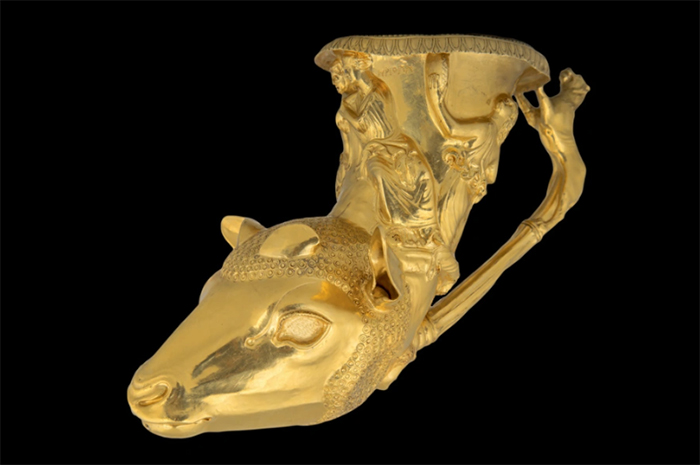
Drinking in style with the ancient Greeks and Persians
Christina Makris 13 JULY 2023 Apollo Magazine
‘Hail and drink me – yes!’ commands the inscription on a cup from the mid sixth century BC, on display in ‘Luxury and Power: Persia to Greece’ at the British Museum (until 13 August). The vessel depicts an agitated Zeus, enthroned on a Persian-style chair, his head splitting open for Athena to be born.
It’s tempting to read this as the father of all hangovers. What is certain is that the drinking paraphernalia on show here allows visitors a fascinating glimpse of the development of drinking culture throughout Persia and Greece between 550–30 BC.
Today we tend to think of ancient instances of drinking and inebriation as ritualistic attempts to commune with the gods. However, objects made during the Greco-Persian Wars (c. 492–449 BC) reveal that drinking had more prosaic functions – whether political, cultural or military. The drinking vessels made in this period demonstrate how wine-drinking fashions changed over time.
In the imagination of the ancient Greeks, the Persians – and in particular the Achaemenid dynasty – were associated with extreme opulence and luxury. As the expansion of the Persian empire provided it with access to new materials, everyday objects began to be made from silver and gold and decorated with precious stones. In around 370 BC, the soldier-philosopher Xenophon wrote of the Persian fondness for ‘fancy side dishes and all sorts of sauces’ – and Persian dining customs necessitated specific tableware, for instance small dishes and specific serving bowls. The exhibition includes a solid gold tableware service, dating from 500–330 BC, adorned with intricate details of animals, fruit and flowers. One silver bowl, from the same period, depicts an idealised Persian hero.
Lion’s head drinking cup (500–470 BC), attr. to Douris. The Trustees of the British Museum
The Greeks often maintained that the Persians drank to excess. In the third century AD, Athenaeus wrote that the tomb of Darius the Great was inscribed with the words: ‘I was able to drink a great deal of wine and to bear it well.’ No inscription of this kind has ever been found, but it is true that the Persians had a taste for thick and potent wine, served and drunk from intricately designed vessels that formed an integral part of the performative drinking culture at court. They include the rhyton: a conical container of silver or gold, typically in the form of an animal, with a wide hole at the top and a smaller hole – the animal’s mouth – at the bottom. Courtiers would balance the serving bowl on one hand, and lift the rhyton high with the other, pouring the wine from above. The examples in the exhibition, dating from 500–300 BC, take the shape of griffins, gazelles, rams and a horse and rider.
Also on display are silver ladles decorated with animal heads and pomegranate motifs. These would be used by the royal cup-bearers – one of whose functions was akin to that of the modern sommelier, recommending wines and adjusting their taste to complement the region of the empire the king would be hosting his banquet in. Wines came from Sicily, Armenia, Macedonia and Sogdiana. Using the ladle was another elaborate procedure: the server would hold the handle from the pinkie of one hand, guiding the flow of drink into the bowl with the other three fingers. Frescoes of 480–470 BC from the tomb of Karaburun II in present-day Turkey depict this performance in action.
There are a number of vessels and vases in the exhibition made during the Age of Pericles, some 20 years after the Greeks had repelled the Persian invasion, that depict Persians in scenes of ridicule and humiliation. From around 460 BC – during the wars of the Delian League – there are drinking cups designed in the form of the heads of Persian soldiers. Their faces are frozen in fear, while the base of the cups are decorated with images of Athenian women being served at their toilet by Persian slave girls. Even more severe are a pair of oenochoe (wine jugs) from 460 BC. One depicts a red-figure Greek soldier, charging forward while holding his penis; on the other stands a Persian soldier, his arms held high in surrender. The inscription reads: ‘I am Eurymedon, you stand bent over.’
For their part, the Greeks diluted their wine with water and added other ingredients such as honey and spices. During symposia – after-dinner drinking sessions accompanied by music and dancing – four vessels were used for the preparation of the drink. A krater was used to mix the wine with water, with a hydria used to hold the water. The oenochoe was used to serve guests, who would drink from a kylix.
The decoration on all of these vessels reveals the changing attitudes of the Greeks towards the Persians. By the later part of the fifth century BC, memories of past battles had begun to recede – and there was a growing fascination with everyday Persian luxury. One kylix from 430 BC shows the 12 Olympian gods at a symposium, each holding a Persian-shaped bowl – one of many depictions of Achaemenid-style vessels and jugs on Attic vessels. A relief dating from 330–300 BC depicts a hero in the afterlife, holding a rhyton and balancing the bowl with his other hand, in the Persian serving tradition.
Throughout history, wine-drinking customs have offered a window on the workings of geopolitical influence. The drinking vessels on display in the exhibition attest that, despite their fierce rivalry, Greek eyes were opened to the sumptuous designs of the Persians, and integrated into their arts and rituals. To adapt Brillat-Savarin’s brilliant aphorism: tell me how you drink, and I’ll tell you who you are.
